Affiliate disclosure: This post may contain affiliate links. Please see our Privacy Policy.
Tomatillos are one of the easiest crops to grow in the home garden, and plants yield pounds of fruit even with no care or weeding. Growing tomatillos is extremely rewarding because they’re a dependable crop even in the worst years. Tomatillos are a quick win for new gardeners, and perfect for growing with kids.
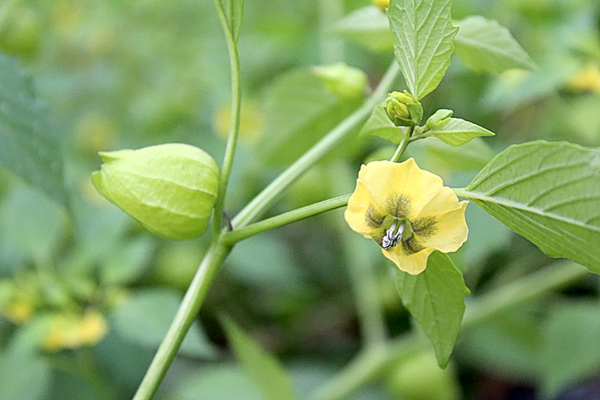
The first time I planted tomatillos was a decade ago, on a second date with the man that would eventually become my husband. He tilled up a section of hayfield next to to the old farmhouse he was caretaking that summer, and we set out a garden for his small homestead. That was the only care they ever received, and we spent the rest of the summer falling in love instead of gardening.
The hayfield grew back up around them and we forgot all about the tomatillos and the rest of the garden until the fall. Out taking a walk after dinner, we felt tiny golf ball sized orbs popping beneath our feet.
Those 6 tomatillo plants produced 40 pounds of fruit, even fighting waist-high grass. We harvested a wheelbarrow full with a rake, pulling them from the dense grass.
We still grow tomatillos every year, and there are inevitable volunteers all around the yard. They’ll sprout up right out of the lawn, and this year we have dense patches growing next to the gravel driveway.
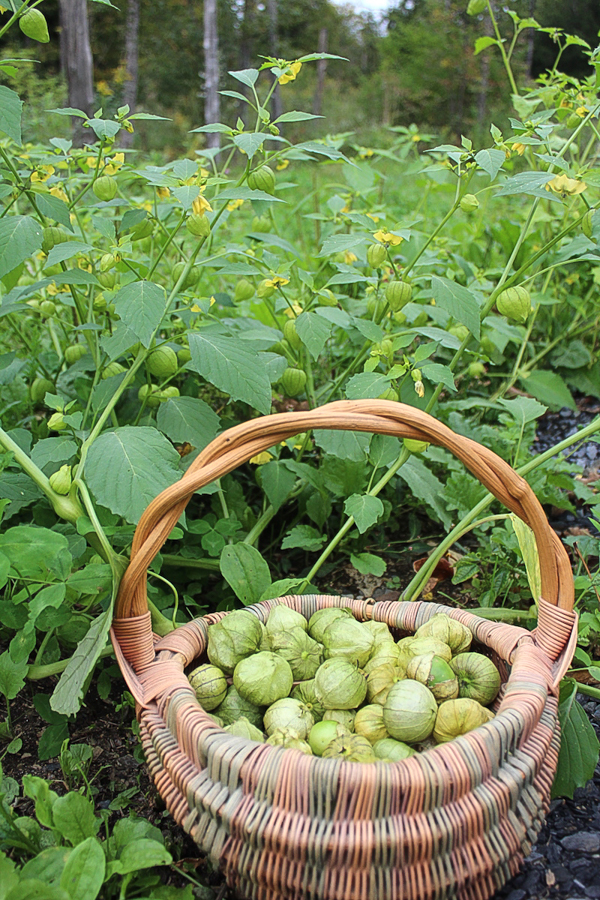
Growing Tomatillos
Growing tomatillos is very similar to growing tomatoes, eggplants and peppers in the garden. They can be started from seed or purchased as plant starts, but either way, they need a head start on the growing season in areas with cool, short summers.
If you’re growing tomatillos from seed, start seeds indoors 6 to 8 weeks before the last frost. Plant seeds 1/4 inch deep in fertile, well-drained potting soil.
Tomatillos can also be direct seeded into the garden after the risk of last spring frost, and just like tomatoes, any forgotten fruits will result in volunteers the following year.
Space plants at least 2 feet apart because plants will grow surprisingly large. They’ll often require some kind of trellis to support heavy crops of fruit, and tomato cages work particularly well.
Tomatillo Varieties
There are a number of tomatillo varieties, and they vary based on plant size, yield and fruit color. The purple fruited varieties are beautiful on the plant, and the husk, as well as the inner skin, has a purple color.
The interior of the fruit remains the same color as green varieties, and the purple color will disappear in cooking. That said, purple varieties offer color for the garden and are perfect to brighten up fresh salsa.
Green Tomatillo Varieties
- Gigante – (100 days) Some of the largest fruits of any variety, sometimes 4” across. Bred for a high sugar content, this variety has 50% more sugar than other varieties. Sprawling growth habit. (Seeds Available Here)
- Tamayo– (65 days) Very large fruit, especially for an early tomatillo, reaching 2 1/2 to 3” across. The fruit are juicy and crunchy, making them perfect for fresh salsa. Sprawling growth habit. (Seeds Available Here)
- Toma Verde – (60 days) Deep green fruit, high yields and a rich flavor. Fruits ripen extra early, making this a great variety for short-season areas. Sprawling growth habit. (Seeds Available Here)
- Rio Grande – (85 days) Extra large fruits are 3 to 4 ounces each. The upright plant does not usually require staking. (Seeds Available Here)
Purple Tomatillo Varieties
- Purple Coban – (70 days) A heirloom variety brought from Coban Guatemala. Produces 1” fruits with a purple skin. (Seeds Available Here)
- Purple De Milpa – (70 days) A heirloom variety said to grow wild in Mexican cornfields. Small 1” fruits have an intense flavor. (Seeds Available Here)
Pollinating Tomatillos
Unlike tomatoes, which often self-pollinate within the same flower, tomatillos require two different plants for pollination. While you need two distinct plants, they can be from the same variety, so there’s no need to buy more than one seed packet for successful tomatillo pollination.
The plants are bee-pollinated, and like many other garden crops (melons, pumpkins, etc) they will not set fruit without a population of bees nearby to visit the flowers. Native bumblebees love our plants and ensure a good tomatillo harvest every year.
If you don’t have a healthy local bee population, tomatillos can be pollinated by hand with a q-tip. Just go back and forth between the flowers of two different plants, dipping the q-tip into each blossom and giving it a gentle nudge.
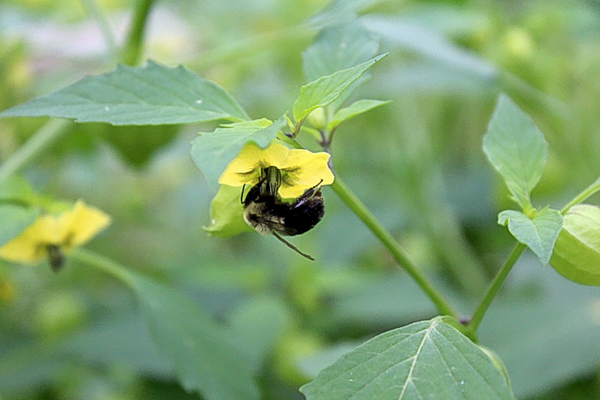
Harvesting Tomatillos
Tomatillo plants often have very heavy yields, even with marginal growing conditions. Fruits will ripen over the course of several months, with the heaviest crops late in the fall. Several plants are required for pollination, and having at least 3 or 4 plants in the garden will ensure that you have enough ripe fruit at any one time to use in recipes.
The fruits of the tomatillo are ripe when they grow large and fully fill out the papery husk. The fruit should be dark green, and any fruits that have started to lighten or yellow are overripe.
At the end of the season, when frost threatens, pull up the whole plants or cut them off at ground level. Hang the whole plant with fruit attached in a cool root cellar or garage and the fruits will keep on the plant for several months.
How to Use Tomatillos
Southwestern cooking often calls for tomatillos, and they’re a key ingredient in fresh green summer salsa. My favorite way to use tomatillos is in my homemade canned green enchilada sauce.
I’ll use it for enchiladas of course, but also for braising pork or chicken in the oven. Canning whole tomatillos is a great way to preserve them for winter soups and stews.
Like their sweet cousin the husk cherry, the fruits will store for a few months in a root cellar or cool pantry.
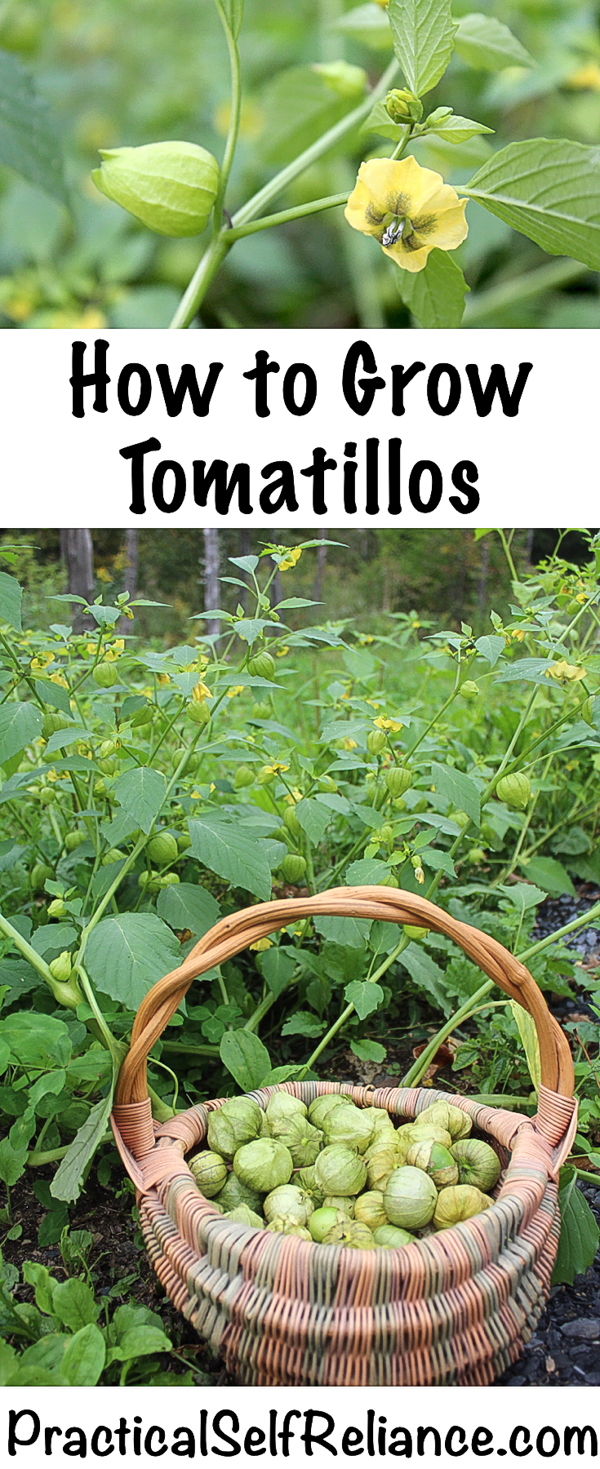

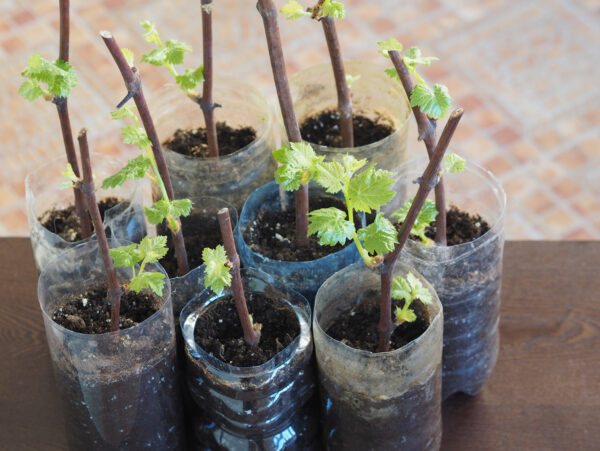
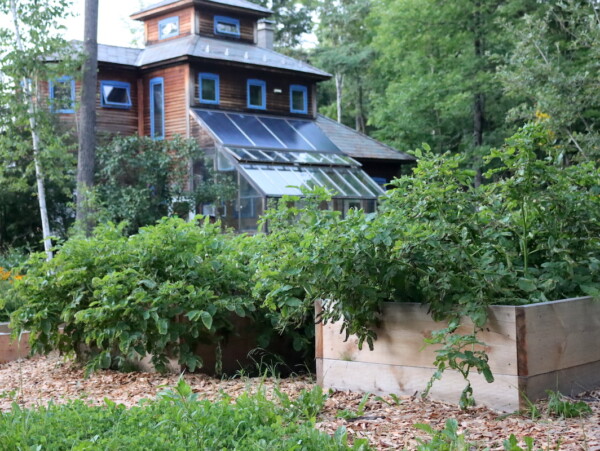
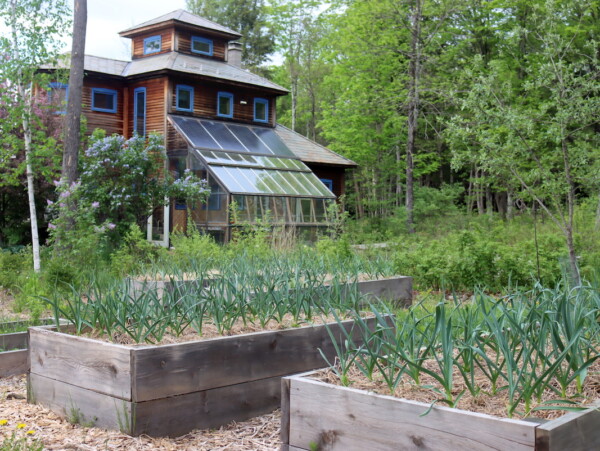
How do you prune tomatillos?. Have been growing them for 2 decades, but the last 4 seasons have been very poor production-wise. I used to never have that problem. It used to be “plant them and walk away”. I used to get prolific harvests, but the last four years a scant few harvests. How can I get back those harvests? What can I do?
That is a darn good question. For me, they’re always plant and walk away and they produce buckets of fruit. I wonder what’s going wrong?
I started seeds and actually started ground cherries AND tomatillos, not realizing the plants look nearly identical and so do the fruits! I guess I shall try to taste the difference lol? I tagged the ground cherries but when they looked like the huge tomatillo plant I had growing, I assumed it was tomatillo. Now I’m second guessing both of them.
Next year I will be more diligent about labeling!
Thanks for a great post!
Ooops. Ha ha. You will know for next time. You’re welcome. Glad you enjoyed it.
What a wonderful article. I don’t normally like all the blurb people write and go straight to the nitty gritty, but yours was a lovely little story.
I’m growing Plaza Giant tomatillos for the first time in Spain and you have provided all the info required. Thank you!
You’re very welcome. Thank you so much for sharing. We’re so glad that you enjoyed the post.
Hi there,
Love your site! Thanks for the valuable information.
One question regarding tomatillo flowers. When I try to collect the pollen on a Q-tip I don’t see anything… am I supposed to be touching the blue pistills or the back of the flower? What color should I see?
Here is a quick video that I found that might be helpful for you. It shows tomatillo pollination. She uses a black brush which may make it easier to see the pollen. You just want to go right inside the flower blossom. https://youtu.be/B8rTFPaP5ts
we live in northeast florida (Jacksonville). We finally got tomatoes to grow last summer using grow boxes. I am looking forward to a crop of tomatillos as I do quite a bit of mexican cooking. I have been canning most of my young AND adult life – my neighbors laugh at all my hard labor !! What type of tomatillo would you recommend for our hot humid climate? Thank you so much for your blog.
Tomatillos actually thrive in hot and humid climates so you should be able to do well with any variety.
I’m in Utah and growing them for the 1st. time. I’m learning.
That’s so exciting. Don’t you just love learning new things?
Today I purchased one tomatillo plant, came home to research how to grow it and learned that I needed a second plant. So I went back to the nursery to get a second plant. When I got home, I realized I’d purchased a different variety. Do you think I’ll get fruit – will they pollinate one another? Thanks!
That’s best actually. They’ll cross-pollinate that way. Good luck!
I was so excited to find this on Pintrest. I live in San Antonio so when would I need to plant and what kind of tomatillo do you recommend?
I’m not familiar with the climate in San Antonio, so I can’t make any specific recommendations for you, but look up any local guide to tomatoes and follow those planting timetables.